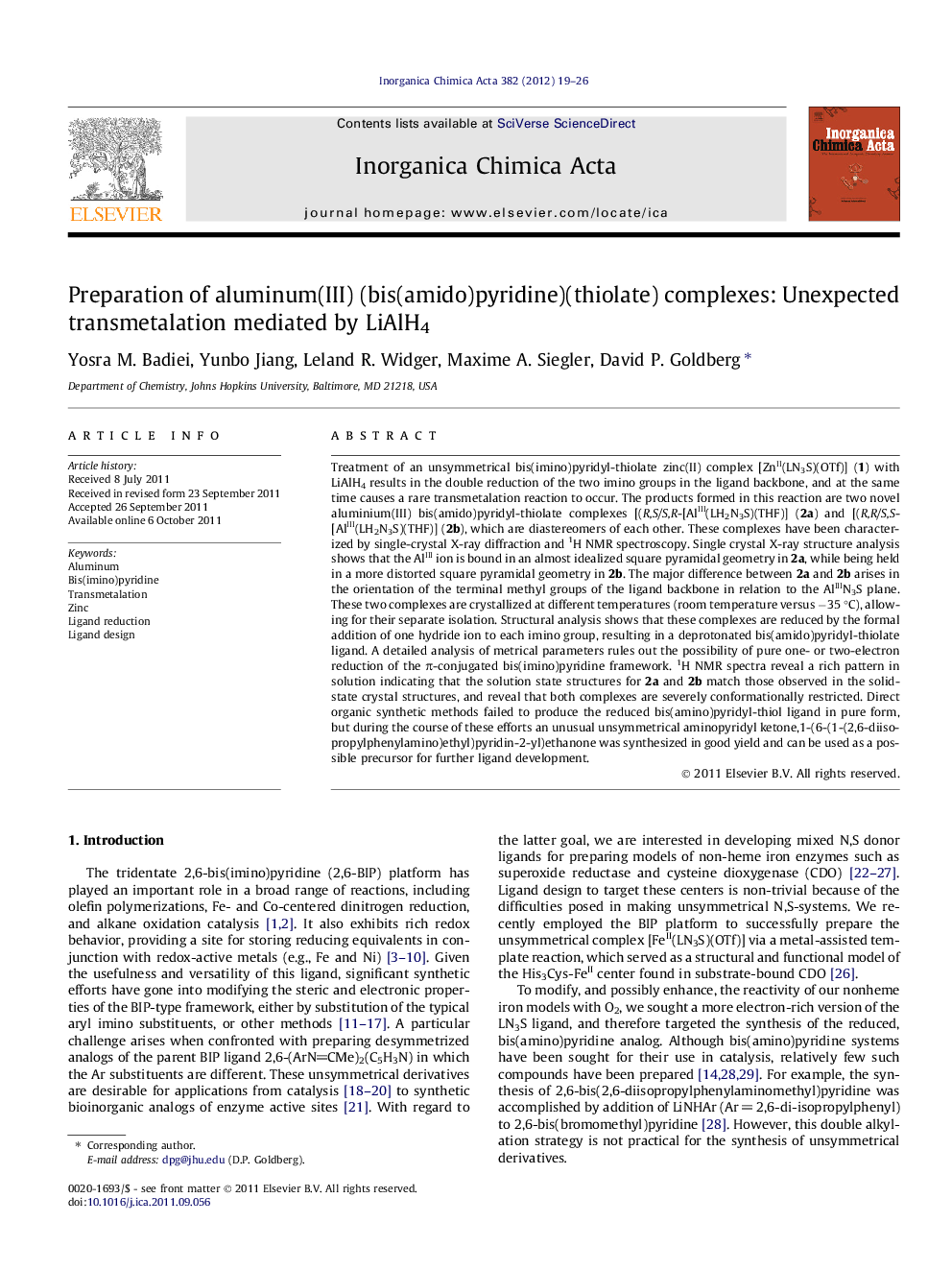| کد مقاله | کد نشریه | سال انتشار | مقاله انگلیسی | نسخه تمام متن |
|---|---|---|---|---|
| 1307313 | 1499205 | 2012 | 8 صفحه PDF | دانلود رایگان |

Treatment of an unsymmetrical bis(imino)pyridyl-thiolate zinc(II) complex [ZnII(LN3S)(OTf)] (1) with LiAlH4 results in the double reduction of the two imino groups in the ligand backbone, and at the same time causes a rare transmetalation reaction to occur. The products formed in this reaction are two novel aluminium(III) bis(amido)pyridyl-thiolate complexes [(R,S/S,R-[AlIII(LH2N3S)(THF)] (2a) and [(R,R/S,S-[AlIII(LH2N3S)(THF)] (2b), which are diastereomers of each other. These complexes have been characterized by single-crystal X-ray diffraction and 1H NMR spectroscopy. Single crystal X-ray structure analysis shows that the AlIII ion is bound in an almost idealized square pyramidal geometry in 2a, while being held in a more distorted square pyramidal geometry in 2b. The major difference between 2a and 2b arises in the orientation of the terminal methyl groups of the ligand backbone in relation to the AlIIIN3S plane. These two complexes are crystallized at different temperatures (room temperature versus −35 °C), allowing for their separate isolation. Structural analysis shows that these complexes are reduced by the formal addition of one hydride ion to each imino group, resulting in a deprotonated bis(amido)pyridyl-thiolate ligand. A detailed analysis of metrical parameters rules out the possibility of pure one- or two-electron reduction of the π-conjugated bis(imino)pyridine framework. 1H NMR spectra reveal a rich pattern in solution indicating that the solution state structures for 2a and 2b match those observed in the solid-state crystal structures, and reveal that both complexes are severely conformationally restricted. Direct organic synthetic methods failed to produce the reduced bis(amino)pyridyl-thiol ligand in pure form, but during the course of these efforts an unusual unsymmetrical aminopyridyl ketone,1-(6-(1-(2,6-diisopropylphenylamino)ethyl)pyridin-2-yl)ethanone was synthesized in good yield and can be used as a possible precursor for further ligand development.
Reaction of an unsymmetrical bis(imino)pyridyl-thiolate zinc(II) complex [ZnII(LN3S)(OTf)] (1) with LiAlH4 results in the reduction of the bis(imino) groups and the unexpected transmetalation of ZnII with AlIII. The diastereomeric products [(R,S/S,R-[AlIII(LH2N3S)(THF)] (2a) and [(R,R/S,S-[AlIII(LH2N3S)(THF)] (2b) were characterized by X-ray crystallography and 1H NMR spectroscopy.Figure optionsDownload as PowerPoint slideHighlights
► Synthesis and characterization of novel AlIII bis(amido)pyridyl-thiolate complexes.
► Reduction of ZnII(LN3S)(OTf) with LiAlH4 results in a rare transmetallation reaction.
► Complexes characterized by X-ray diffraction and 1H NMR spectroscopy.
► Analysis rules out the possibility of one or two-electron reduction of the ligand.
► Transmetalation reaction may be relevant to olefin polymerization.
Journal: Inorganica Chimica Acta - Volume 382, 15 March 2012, Pages 19–26